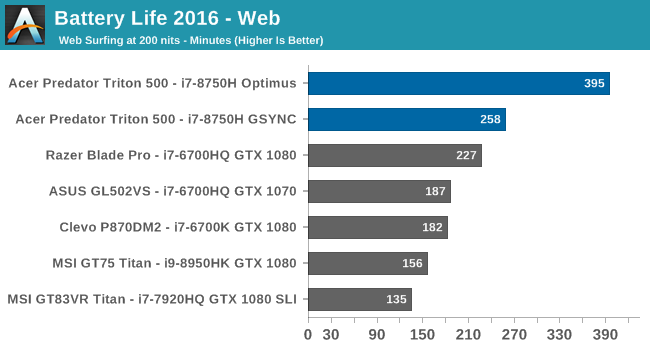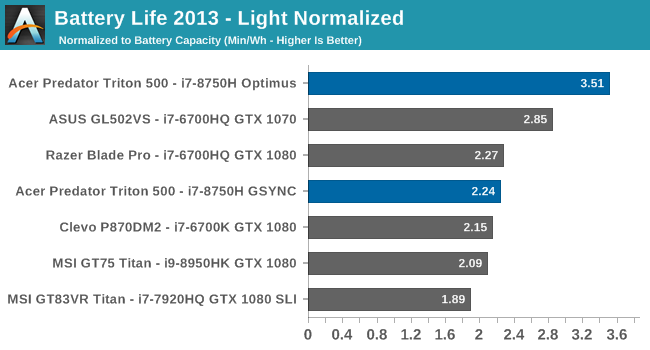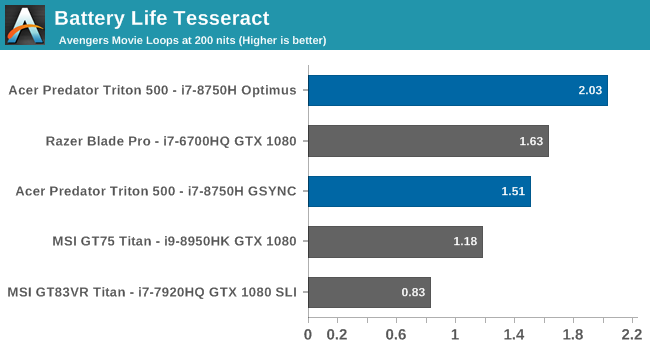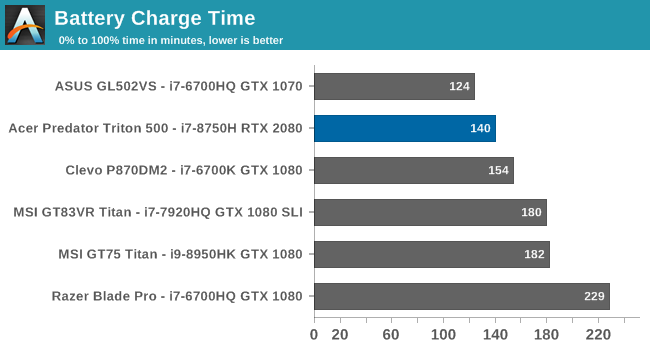The Acer Predator Triton 500 Laptop Review: Going Thin with GeForce RTX 2080
by Brett Howse on April 25, 2019 8:00 AM ESTBattery Life and Charge Time
Battery life takes a back seat in gaming laptops, especially since the nature of G-SYNC requires that the dGPU has to be directly connected to the display, and therefore Optimus is unavailable. Update: Some readers have let me know that Acer offers an option in the BIOS or in their PredatorSense to choose between having G-SYNC or Optimus, meaning they have a MUX installed allowing the GPU to be directly connected to the display, or through the iGPU for battery life. The Battery Tests were re-run with Optimus enabled. Running a massive GPU to do desktop tasks takes a lot of power, full stop. Acer has offered an 84 Wh battery to try to compensate, and they also offer optional Optimus which means you can get some battery life savings by disabling G-SYNC and using the Intel iGPU for light loads.
2013 Battery Life Light

Our lightest test just cycles four web pages per minute, and isn’t very much work for a modern system. With Optimus enabled, the battery life is very reasonable for a gaming laptop system. The base power drain is still quite high, but compared to gaming systems that don't offer Optimus the Acer is far ahead.
2016 Web

Our newer web test is much more demanding of the processor, and generally results in quite a bit drop in time compared to the light test, but gaming laptops are a different beast, and the high base power draw generally masks any such changes in CPU usage. In fact, the more demanding test actually provided slightly longer runtime, and with Optimus enabled the battery life is downright reasonable.
Normalized Results


Removing the battery size from the results gives us our normalized results, where we can see the efficiency of the various platforms. The Acer Predator Triton 500 is actually a fairly efficient gaming laptop, even though it’s still not great. The industry is actually making progress here, just far slower than they are on the Ultrabook side. The Acer allows the GPU to be switched off with a multiplexer, and when Optimus is enabled the efficiency is significantly higher. The downside is it does require a reboot, and you lose G-SYNC until you re-enabled and reboot again, but if there are scenarios where the extra battery life is needed, the Acer offers the best of both worlds.
Movie Playback

Once again with Optimus enabled the battery life is reasonable here, and it's a fantastic option that Acer has to allow you to choose between Optimus and G-SYNC. The base power draw is still quite high compared to an Ultrabook, but the overall runtime is a lot better than a gaming laptop that forces the media playback to leverage the dGPU.
Tesseract

Dividing move playback time by the length of a long movie gives us our Tesseract score, and you can playback the Avengers about 1.5 times before this laptop shuts off with G-SYNC enabled, and two movies played back with Optimus enabled.
Battery Life Conclusion
Acer is one of a few manufacturers offering a multiplexer on the dGPU, allowing the end user to choose between Optimus and G-SYNC, and the results are worth it. If you are doing desktop work and need some extra battery life, the Triton 500 deilvers far more than most gaming laptops. It can't keep up with a low-powered Ultrabook here, but still easily outclasses the competition that does not offer the MUX.
Charge Time
Acer ships the Triton 500 with a 180-Watt AC Adapter with a barrel connector. For those wishing for USB-C charging, the maximum power for USB-C power distribution is 100 Watts, which is not enough for a gaming laptop, which is why they still rely on proprietary power connectors.

You can go from zero to full charge in just over two hours with this laptop, which is pretty good considering the size of the battery. But most likely, the battery will be a mini-UPS for moments when the power goes out anyway, since this laptop is made to be plugged in most of the time.










46 Comments
View All Comments
MrRuckus - Thursday, April 25, 2019 - link
This... Do yourself a favor and compare. 2080 Max-Q to standard 2080 you're looking at an average 30% drop in performance. No thanks. To me its a niche market that doesn't make a lot of sense. You want portability, but these are not meant to game on battery. They're meant to be plugged in all the time. Thinner and Thinner while trying to keep the performance (or the naming scheme of performance oriented parts) seems like an ever increasing losing battle. I personally wouldn't pay the premium 2080 price for a 30% hit in performance.DanNeely - Thursday, April 25, 2019 - link
Thin and light enough to pass as a normal laptop, while still able to game significantly better than on an IGP is a valid market segment; and at the x60 level is probably what I'll be getting for my next laptop in a year or two. OTOH for people who want something that's a normal laptop first and a gaming system second, I suspect Optimus (for battery life) over GSync is probably the better choice until/unless NVidia can integrate the two.Rookierookie - Thursday, April 25, 2019 - link
Yeah, I wish they had a version that offered a FHD panel with Optimus. No 4K, no GSync, and lasts at least 6 hours on battery surfing the web. The Gigabyte Aero is still more or less the only viable option for thin, light, powerful, and decent battery.The ConceptD 7 that comes out later this year looks really attractive, but it has a 4K panel so again I'm not optimistic about battery time.
Opencg - Thursday, April 25, 2019 - link
optimus is great with the exception of when they wire the igpu to the external ports. imo you should be able to plug into a vr headset or external gsync monitor. you might give up the ability to run a presentation on a projector in low power optimus mode but imo when you are pluging into external displays you are probably plugging into the wall anyway.Brett Howse - Thursday, April 25, 2019 - link
Apparently this laptop has a MUX to allow you to choose between G-SYNC and Optimus. I've updated the article and am re-running the battery life tests right now and will add them in when done. So really this is the best of both worlds.jordanclock - Thursday, April 25, 2019 - link
The biggest problem is that Max-Q can mean everything from specs that match the desktop down to half the TDP rating. So a 2080 Max-Q can be below a 2070 Max-Q depending on how each OEM configures the TDPs and clocks.Tams80 - Saturday, April 27, 2019 - link
You're clearly not the market for it.There is a significant market for one machine that is as best as possible for gaming when plugged in, but decent as an everyday machine when not. I'd say that market also value the machine being light for transporting between places.
You may poo poo such a use case, but it can be very tiresome maintaining more than one machine. People are willing to pay a premium for lower specs for that. Then there are those who just want the 'best' numbers in everything, but they'll buy anything.
Fallen Kell - Monday, April 29, 2019 - link
Except that he is the market. The complaint is that these companies are putting in features that they are marketing the device on which the device has no chance of being able to accomplish. This device isn't the best as possible for gaming when plugged in. It can't cool itself even when plugged in to have even a chance of using the 2080 GPU or even the CPU for more than a few seconds before thermal throttling. These shenanigans should ALWAYS be called out. If they want to make a thin laptop, then they should put in hardware that it can actually use at full capability without thermal or power throttling when plugged in. In this case, it would probably mean stepping down the CPU and GPU.
The marketing guys know that will affect sales because they can't say they have the top of line components, but the whole max-q that Nvidia released along with relying on Intel's thermal throttling is letting companies say they have all this hardware in a thin laptop and people are buying them thinking they have that hardware, not knowing they are buying something that is possibly running 30-40% slower than it should be and could have saved hundreds of dollars and had the exact same performance if they simply used the "slower" parts that worked in the thermal and power loads of the laptop in the first place.
plewis00 - Saturday, April 27, 2019 - link
Totally agree. If you want performance then expect a big machine to cart around. Making things thinner doesn't work all the time, Apple's MacBook range is a great example of how to ruin machines by making them obsessively thin.not_anton - Friday, April 26, 2019 - link
Apple did the same with Macbok pro 15, my Radeon 460 works at mere 960MHz with decent performance and ridiculously low power for a 1000-core GPU chip.The downside is the value for money that you'll get - about the same as Apple's :D